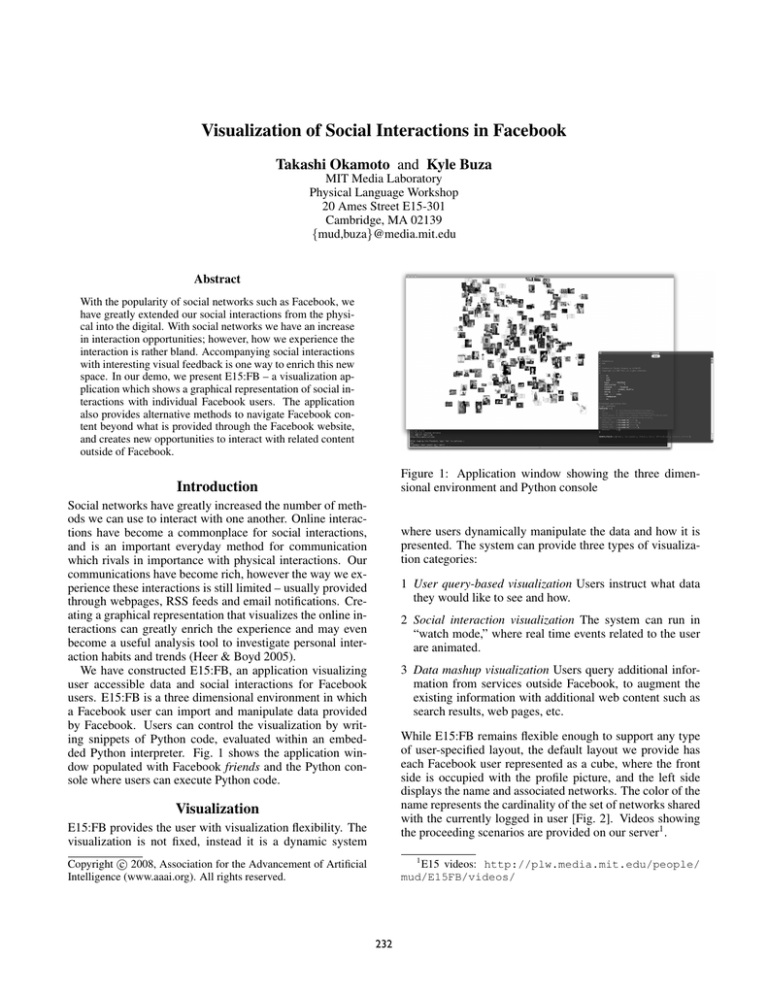
Visualization of Social Interactions in Facebook
Takashi Okamoto and Kyle Buza
MIT Media Laboratory
Physical Language Workshop
20 Ames Street E15-301
Cambridge, MA 02139
{mud,buza}@media.mit.edu
Abstract
With the popularity of social networks such as Facebook, we
have greatly extended our social interactions from the physical into the digital. With social networks we have an increase
in interaction opportunities; however, how we experience the
interaction is rather bland. Accompanying social interactions
with interesting visual feedback is one way to enrich this new
space. In our demo, we present E15:FB – a visualization application which shows a graphical representation of social interactions with individual Facebook users. The application
also provides alternative methods to navigate Facebook content beyond what is provided through the Facebook website,
and creates new opportunities to interact with related content
outside of Facebook.
Figure 1: Application window showing the three dimensional environment and Python console
Introduction
Social networks have greatly increased the number of methods we can use to interact with one another. Online interactions have become a commonplace for social interactions,
and is an important everyday method for communication
which rivals in importance with physical interactions. Our
communications have become rich, however the way we experience these interactions is still limited – usually provided
through webpages, RSS feeds and email notifications. Creating a graphical representation that visualizes the online interactions can greatly enrich the experience and may even
become a useful analysis tool to investigate personal interaction habits and trends (Heer & Boyd 2005).
We have constructed E15:FB, an application visualizing
user accessible data and social interactions for Facebook
users. E15:FB is a three dimensional environment in which
a Facebook user can import and manipulate data provided
by Facebook. Users can control the visualization by writing snippets of Python code, evaluated within an embedded Python interpreter. Fig. 1 shows the application window populated with Facebook friends and the Python console where users can execute Python code.
where users dynamically manipulate the data and how it is
presented. The system can provide three types of visualization categories:
1 User query-based visualization Users instruct what data
they would like to see and how.
2 Social interaction visualization The system can run in
“watch mode,” where real time events related to the user
are animated.
3 Data mashup visualization Users query additional information from services outside Facebook, to augment the
existing information with additional web content such as
search results, web pages, etc.
While E15:FB remains flexible enough to support any type
of user-specified layout, the default layout we provide has
each Facebook user represented as a cube, where the front
side is occupied with the profile picture, and the left side
displays the name and associated networks. The color of the
name represents the cardinality of the set of networks shared
with the currently logged in user [Fig. 2]. Videos showing
the proceeding scenarios are provided on our server1 .
Visualization
E15:FB provides the user with visualization flexibility. The
visualization is not fixed, instead it is a dynamic system
1
E15 videos: http://plw.media.mit.edu/people/
mud/E15FB/videos/
c 2008, Association for the Advancement of Artificial
Copyright Intelligence (www.aaai.org). All rights reserved.
232
the door to many new possibilities for exploring new webcentric visualizations that leverage the data obtained from
Facebook. For example, we perform proximity-based user
name searches to display relevant URLs (and their associated web page) for a given Facebook user. This opens the
possibility for forms of gestural browsing that do not require
keyboard input from the user.
Implementation
E15:FB is a Python script that runs on E15 (Buza et al.
2007). E15 is a three-dimensional OpenGL-based web environment, enabling new interactions with web content beyond the traditional browser. E15’s main interface is a
Python console, and we can use a wide range of Python libraries that are readily available. The communication between Facebook and E15:FB is established using the Facebook REST API (Facebook 2007). The notifications are
parsed from the notification RSS feed provided by Facebook
for each user. The system currently runs on a 8-core 3.0GHz
Mac Pro running Mac OS X 10.5.2, with an ATI X1900 XT
graphics card. Users can freely fly through the environment
with two 3D mice, where translation and rotation motions
are controlled individually by each mouse. Arrow keys are
also mapped to move the view from one user to another.
Figure 2: Application window showing current logged in
user with friends
User Query
E15:FB begins by authenticating with a Facebook login,
then asynchronously populating the three dimensional environment with graphical representations of the user’s friends
in a random position specified within a cubic region. With
this state as the starting point, the user can begin executing
commands on the Python console. The user can freely move
each friend around in space by issuing a new coordinate, and
use two 3D mice to freely fly through the space. Additionally, a command can be executed to animate the camera to
put a specific friend into view with proper orientation.
The user can also organize friends spatially. For instance, the user can execute a command that will organize
the friends linearly along the z-axis – ordered alphabetically
by name. Another method is to cluster friends into different regions by determining how many networks they have
in common with the user. This and other arrangements are
simple to implement – often in less than five lines of Python
code. The user can also display all photographs a specific
friend appears in. All photographs can be displayed in the
environment at once, which greatly enhances the experience
of browsing through photographs compared to viewing them
individually through the Facebook site.
Conclusion
E15:FB attempts to enrich the experience of social interaction methods enabled by popular social networking sites.
With data available through web APIs, social networks do
not have to be accessed or interacted directly through their
websites inside a conventional web browser. Without the
need to run inside a web browser, we can use software and
hardware facilities available to desktop applications such as
hardware accelerated graphics rendering. Currently, we are
working to integrate visual effects such as blurring to visually represent intelligent filtering of friends. We are also
extending ways to integrate Facebook data inaccessible with
the web API, by extracting data available on a web page –
such that users can interact with Facebook web pages inside
E15 which will directly augment the visual representation
in the three dimensional environment. Finally, future development plans include reducing the need to execute Python
commands directly by users to minimize stress on novice
users and non-programmers.
Social Interaction
Facebook provides a notification RSS feed for every Facebook user. The notification RSS feed records all events relating to the user, providing a history of transactions within
the previous week. The feed is updated as soon as an event
occurs, and this provides E15:FB with real time interaction
data. By periodically observing the RSS feed, E15:FB can
visualize interactions as they occur. This creates a graphical representation of the social interactions that occur within
Facebook in real time, and can run on its own without user
intervention.
References
Buza, K.; Okamoto, T.; Blackaller, L.; and Hollenbach, K.
2007. E15. http://e15.media.mit.edu.
Facebook. 2007. Facebook REST API. http://wiki.
developers.facebook.com/index.php/API.
Heer, J., and Boyd, D. 2005. Vizster: Visualizing online
social networks. In Proceedings of IEEE Symposium on
Information Visualization (InfoViz05).
Data Mashup
One of the benefits of using an embedded Python interpreter
at the core of E15:FB is the multitude of packages available to extend existing Python functionality. This opens
233


